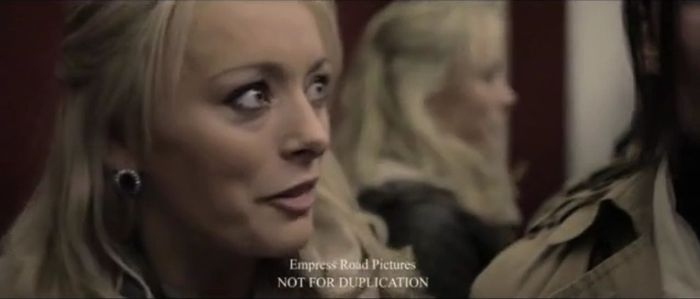|
The Snare Film review by Thomas M. Sipos |
|
MENU Books Horror Film Festivals and Awards
Pursuits
Blogs Horror Film Festivals and Awards
Other
|
The Snare (2017, director
& script: C.A. Cooper;
cast: Eaoifa Forward, Rachel
Warren, Dan Paton)
In The Snare it's an unoccupied -- yet fully furnished? -- apartment building. Lizzy (Rachel Warren) has the keys to the building because her father is an estate agent. What we in the U.S. call realtors. But even if you didn't know what an estate agent was, Lizzy's accent should clue you into this being a British film. Lizzy breaks into the building with her two mates, Carl (Dan Paton) and Alice (Eaoifa Forward). Carl is Lizzy's boyfriend and Alice is the main character. The Snare is told through Alice's perspective. The film begins and ends with her. Like many film friends, Lizzy and Alice are opposites. Lizzy is an exuberant party girl. Alice is quiet, reserved, contemplative. She has dark forebodings even before Lizzy and Carl spring their crazy idea of vacationing in an empty apartment complex. When they arrive, Alice senses something not right in that complex while the other two have fun. Alice senses something watching them. The something is a malignant presence. A supernatural entity with evil intent. We never learn the specifics, which is one of The Snare's strengths. We never see or hear this entity. Its presence is implied through Alice's impressions, and through the misfortunes and misdeeds that befall the characters. They find themselves locked in the building, unable to escape, starving and thirsting. There are worms. There is ominous graffiti from previous residents. Eventually the characters turn on each other. If you want to go highbrow, you might toy with the notion that this "evil presence" is nothing but the characters' imaginings and hallucinations.
The Snare displays admirable cinematography, lighting, composition, staging, and sound design, all of which suggest an evil, albeit unseen, presence. A slightly wide-angle lens captures the building's malevolence (above) when the characters first arrive. A gray, overcast sky and surrounding grounds devoid of people reinforce this malevolent atmosphere. Unsettling compositions and lighting, clever staging and editing, and strong performances, continue to jar the viewer while supporting the film's dramatic events, characters, and themes. Consider the below sequence of shots.
The three characters enter the building's lobby and wait for the elevator. The scene is darkly lit, the characters in silhouette, creating an ominous atmosphere. Alice is facing the elevator.
We cut to Alice, still looking at the elevator. The actress's dimly lit face expresses the character's trepidation. Does she sense something not right? Or is she not right in the head?
We cut to Alice inside the elevator (above). The shot's composition and Alice's expression creates a graphic match with the previous shot. The longer Alice is unable to shake her forebodings, the more serious (we can assume) is the supernatural threat or mental illness. From the composition and staging, it appears that Alice has her back to her two friends. They face the elevator door, while Alice is staring at ... what?
But then we cut to Lizzy ... and the camera pans to include Alice (above two shots). We discover that Alice was standing between Lizzy and Carl all along. Everyone is facing the elevator doors. The image of Lizzy and Carl behind Alice was merely their reflection in the mirror. Creating a sequence of shots that jars the viewer. Yet just as The Snare sets up our expectations for subtle supernatural terror, the film unexpectedly turns gory. Extremely gory. As their situation grows more desperate, the characters behave with disgusting brutality. The latter half of The Snare features actions and imagery as revolting as in the worst of torture porn. A descent from the sublime into the sordid. Even so, the make-up and splatter effects are professional.
The Snare also has a creepy store clerk, nightmares, and a child molestation back story. Is the latter supposed to explain why Alice is more attuned to the building's malevolence? Or to suggest that she is emotionally broken and thus is imagining the evil presence? Is the back story itself one of Alice's fantasies? Written and directed by C.A. Cooper, The Snare borrows from horror past. Certain images seem inspired by The Haunting, The Shining, and Evil Dead. Yet the final work is more original than the sum of its parts, and more original than many of today's horror fare. The Snare presents a familiar horror setup -- young trespassers in an empty building -- with both alluring artistry and distasteful violence, resulting in a distinctive work of supernatural, psychological terror.  |
"Communist Vampires" and "CommunistVampires.com" trademarks are currently unregistered, but pending registration upon need for protection against improper use. The idea of marketing these terms as a commodity is a protected idea under the Lanham Act. 15 U.S.C. s 1114(1) (1994) (defining a trademark infringement claim when the plaintiff has a registered mark); 15 U.S.C. s 1125(a) (1994) (defining an action for unfair competition in the context of trademark infringement when the plaintiff holds an unregistered mark).font>


 Young people in
horror films are always trespassing into closed or abandoned
buildings. Since the 1980s they've broken into shopping malls (
Young people in
horror films are always trespassing into closed or abandoned
buildings. Since the 1980s they've broken into shopping malls (





